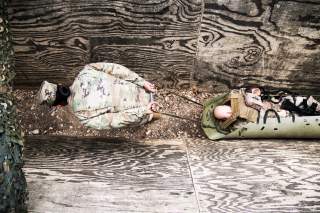World War I Is Long Gone, But Trench Warfare Isn't (I Saw It First-Hand)
The Army got a taste in 2015.
Key point: The creative use of resources and available space can keep readiness high.
“Target down!” Cadet Abigail Toth shouted after unleashing a spray of buckshot. She and Sgt. Marcus Montez moved through the enemy trench. The two soldiers tried to move quickly while navigating the labyrinth of narrow, winding pathways.
It was part of a trench clearing exercise on Aug. 4 with soldiers from the 555th Engineer Brigade’s 570th Sapper Company at Joint Base Lewis-McChord. Members of the company’s 2nd Platoon used the aging trench system to practice with their new M26 shotguns as well as their standard issue M4 carbines.
1st Lt. Anthony Frisone and his platoon sergeant Keith Novembre came up with the idea of assaulting a trench while combining their weapon familiarization training with close-quarters battle tactics.
“It’s better than just going to a range,” Montez — the senior medic — explained. “It’s a lot more tactical and it gives soldiers that feel of moving and shooting.”
Frisone said that when he and Novembre first suggested a trench clearing exercise, they received puzzled looks in response. It’s not hard to see why — trench warfare is more closely associated with 1915 than 2015. In an era of drones, stealth bombers and precision missiles, trench warfare seems downright ancient.
But there’s a method to the sappers’ madness. Frisone argued there’s a lot of value to be had in revisiting old training sites like this one.
As we surveyed the site, it was clear the trenches at JBLM’s Range 23 hadn’t seen regular use for awhile. Thick bushes and overgrowth filled entire sections of the network. “It kind of looks like Jumanji,” Frisone joked.
It wasn’t just plants either. A wide array of creeps and critters had made the trench system their home. “There’s dinosaurs in here,” one soldier remarked after startling what the others described as a “big lizard” that slunk back into the thick brush.
When soldiers began doing practice runs through the trenches firing blanks, they awakened angry hornets that buzzed around the network. At one point, another flying animal surprised the soldiers as they went through the course.
“Is that what I think it is?” a soldier shouted in disbelief as a bat darted out of a crevice. “Yep, that is definitely a bat,” Novembre answered as the cranky mammal flapped its wings in the daylight and flew away.
Some of the wooden beams showed signs of wear and aging. But a soldier said that overall, the trenches are good shape and regular use would keep the foliage from running wild.
“People think, ‘well this is not 1914, we’re not doing trenches anymore,’ and it’s kind of left by the wayside,” Frisone said. But he asserted that with a little imagination and creative thinking, the site has a lot to offer.
“To look at this as just a trench is, I think, pretty short sighted,” the officer explained. He said that the fundamentals of room clearing and close quarters combat remain fairly consistent regardless of wherever they may be. “This can be a trench, or a cave, or even a building with a lot of hallways.”
Frisone explained that military leaders often get attached to training areas, frequently reusing them for exercises. That can be a problem when soldiers become overly familiar with the terrain — as it can lead to complacency.
“They’ll do it so much that they memorize the rooms and it becomes ineffective as a training technique,” the platoon leader said. He figured the trenches were a change of scenery for the sappers.
Toth, a West Pointer attached to 2nd Platoon for a month, said that the trench was a major departure from what she was used to. “It’s probably the first time I’ve done live fire in an environment like this,” the future officer remarked. She said she wouldn’t have thought to use a trench before.
With looming government sequestration and budget cuts set to take effect in October, some military leaders are looking at ways to uses resources more sparingly. There are few firm financial numbers on how hard cuts will hit the Pentagon’s budget in Fiscal Year 2016, but Army brass recently rolled out a plan that would see 40,000 active duty soldiers cut from the force.
Some officials have suggested there could be cuts to facilities, contractors and training sites. That’s caused a great deal of debate in Washington.
But for leaders like Frisone, the primary concern is keeping their soldiers ready — and they’ll do it with whatever they have available. “You don’t need to do these massive funding projects to build these fantastic training facilities,” Frisone said. “I mean, they’re awesome and I’ve gone through a couple of them, but it’s not needed if the money isn’t there.”
Frisone said that creative use of resources and available space can keep readiness high. “We’re doing some fantastic training — that [any unit] can do — to build on those fundamentals in what’s literally a hole in the ground.”
This first appeared back in 2018.
Image: Flickr

